VOLKSWAGEN TOUAREG 2014 2.G Owners Manual
Manufacturer: VOLKSWAGEN, Model Year: 2014, Model line: TOUAREG, Model: VOLKSWAGEN TOUAREG 2014 2.GPages: 620, PDF Size: 9.4 MB
Page 411 of 620

switched of in this mode. Gentle start-ups (getting the vehicle going) and parking are also phases the electrical motor can often handle alone.
The combustion engine is started if you accelerate faster or if the charge level of the high-voltage battery gets too low. As soon as allowed by your acceleration and the high-voltage battery charge level, the vehicle switches back to electrical motor drive.
Use the following indicators to tell when the vehicle is being powered electrically:
�x Tachometer for the combustion engine shows zero engine revolutions.
�x Instrument cluster display.
�x Infotainment System screen.
Extended electro-mode drive (�%�
Page 412 of 620
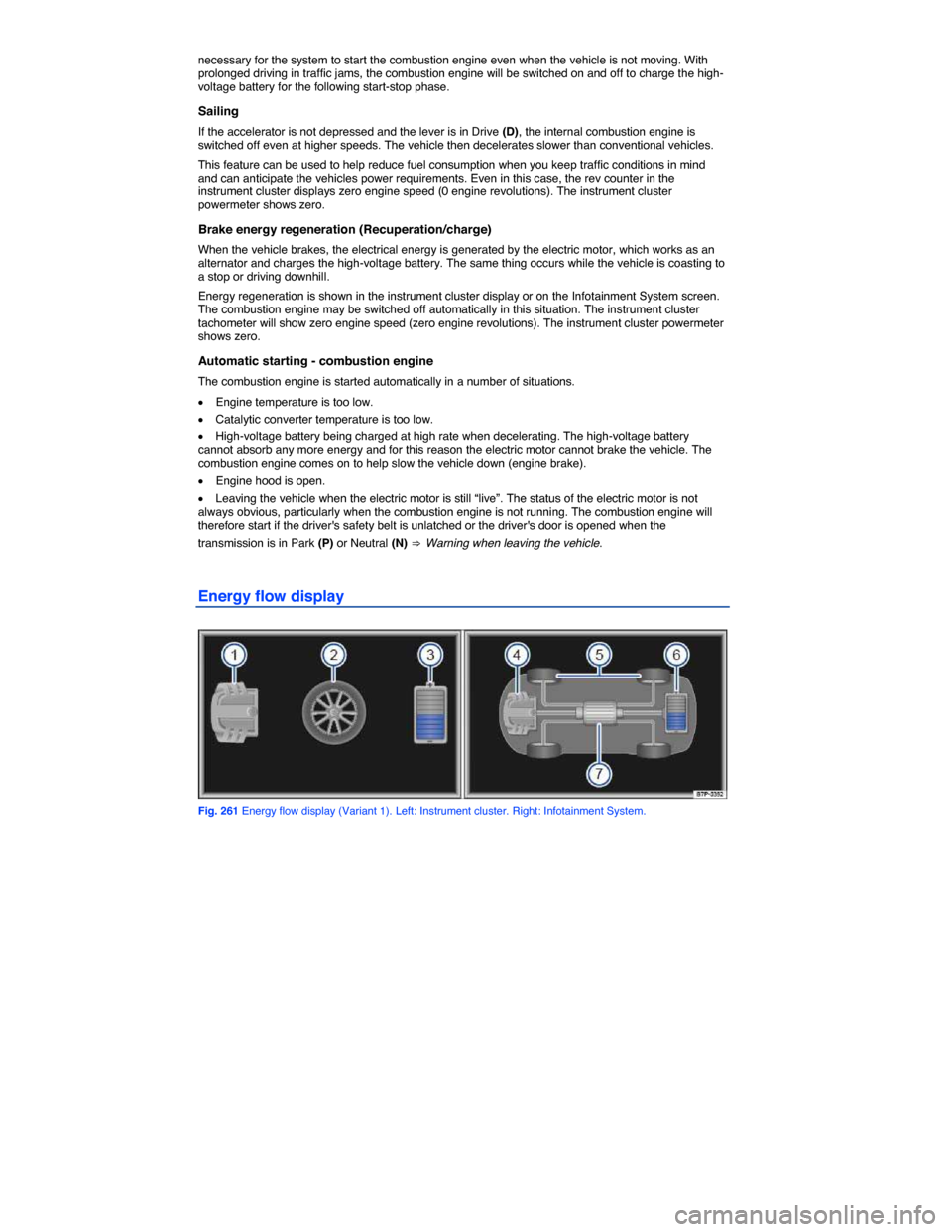
necessary for the system to start the combustion engine even when the vehicle is not moving. With prolonged driving in traffic jams, the combustion engine will be switched on and off to charge the high-voltage battery for the following start-stop phase.
Sailing
If the accelerator is not depressed and the lever is in Drive (D), the internal combustion engine is switched off even at higher speeds. The vehicle then decelerates slower than conventional vehicles.
This feature can be used to help reduce fuel consumption when you keep traffic conditions in mind and can anticipate the vehicles power requirements. Even in this case, the rev counter in the instrument cluster displays zero engine speed (0 engine revolutions). The instrument cluster powermeter shows zero.
Brake energy regeneration (Recuperation/charge)
When the vehicle brakes, the electrical energy is generated by the electric motor, which works as an alternator and charges the high-voltage battery. The same thing occurs while the vehicle is coasting to a stop or driving downhill.
Energy regeneration is shown in the instrument cluster display or on the Infotainment System screen. The combustion engine may be switched off automatically in this situation. The instrument cluster tachometer will show zero engine speed (zero engine revolutions). The instrument cluster powermeter shows zero.
Automatic starting - combustion engine
The combustion engine is started automatically in a number of situations.
�x Engine temperature is too low.
�x Catalytic converter temperature is too low.
�x High-voltage battery being charged at high rate when decelerating. The high-voltage battery cannot absorb any more energy and for this reason the electric motor cannot brake the vehicle. The combustion engine comes on to help slow the vehicle down (engine brake).
�x Engine hood is open.
�x Leaving the vehicle when the electric motor is still “live”. The status of the electric motor is not always obvious, particularly when the combustion engine is not running. The combustion engine will therefore start if the driver's safety belt is unlatched or the driver's door is opened when the
transmission is in Park (P) or Neutral (N) ⇒ Warning when leaving the vehicle.
Energy flow display
Fig. 261 Energy flow display (Variant 1). Left: Instrument cluster. Right: Infotainment System.
Page 413 of 620

Fig. 262 Energy flow display (Variant 2). Left: Instrument cluster. Right: Infotainment System.
�
Page 414 of 620
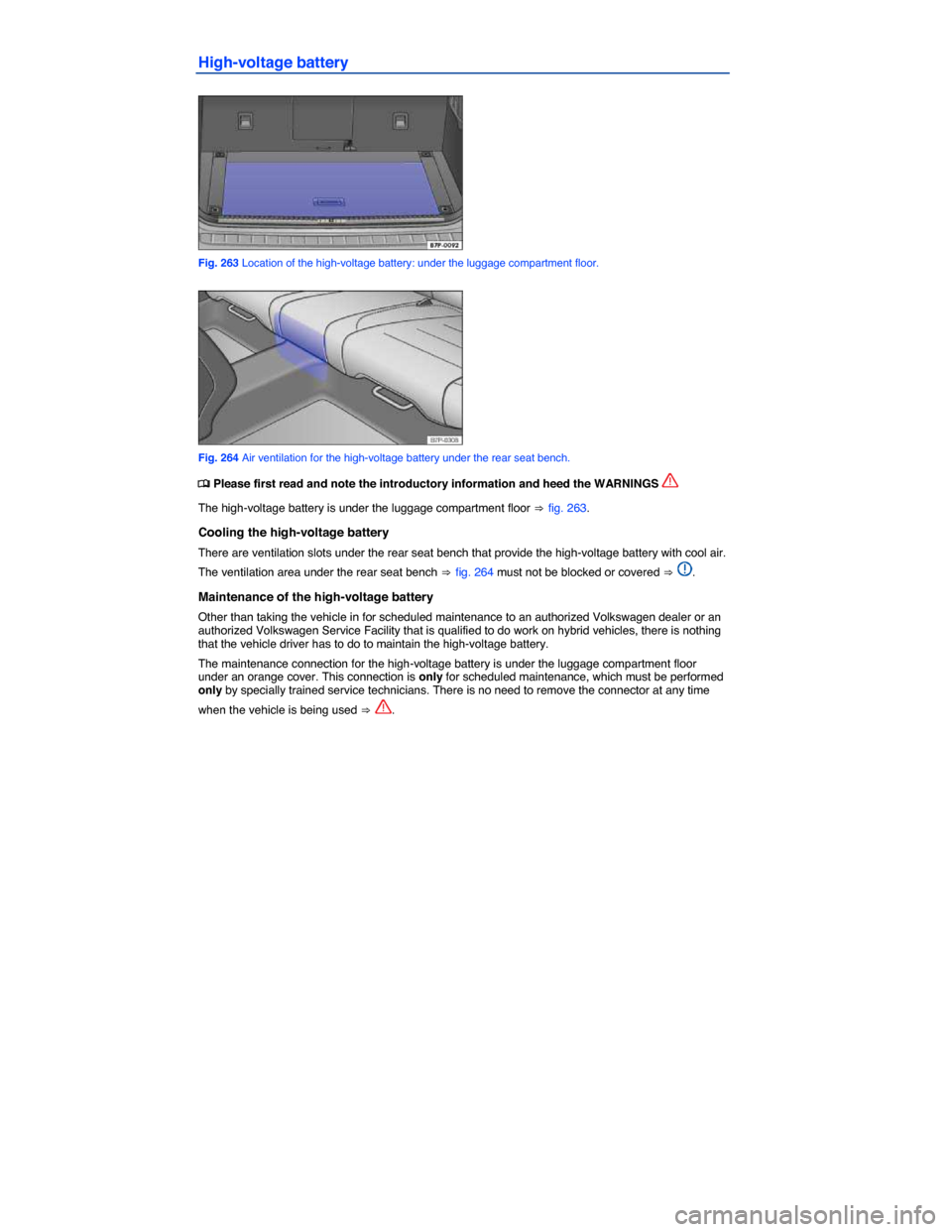
High-voltage battery
Fig. 263 Location of the high-voltage battery: under the luggage compartment floor.
Fig. 264 Air ventilation for the high-voltage battery under the rear seat bench.
�
Page 415 of 620
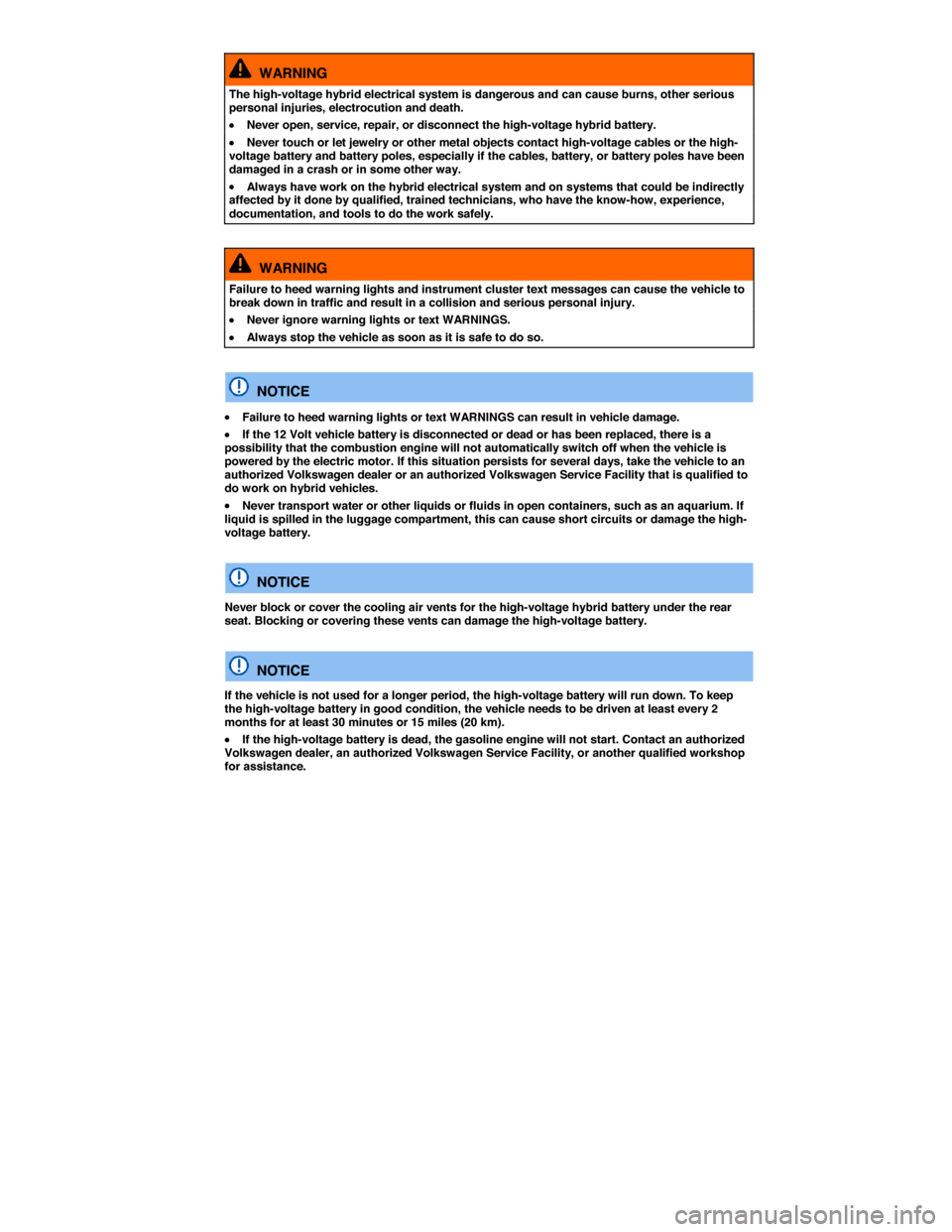
WARNING
The high-voltage hybrid electrical system is dangerous and can cause burns, other serious personal injuries, electrocution and death.
�x Never open, service, repair, or disconnect the high-voltage hybrid battery.
�x Never touch or let jewelry or other metal objects contact high-voltage cables or the high-voltage battery and battery poles, especially if the cables, battery, or battery poles have been damaged in a crash or in some other way.
�x Always have work on the hybrid electrical system and on systems that could be indirectly affected by it done by qualified, trained technicians, who have the know-how, experience, documentation, and tools to do the work safely.
WARNING
Failure to heed warning lights and instrument cluster text messages can cause the vehicle to break down in traffic and result in a collision and serious personal injury.
�x Never ignore warning lights or text WARNINGS.
�x Always stop the vehicle as soon as it is safe to do so.
NOTICE
�x Failure to heed warning lights or text WARNINGS can result in vehicle damage.
�x If the 12 Volt vehicle battery is disconnected or dead or has been replaced, there is a possibility that the combustion engine will not automatically switch off when the vehicle is powered by the electric motor. If this situation persists for several days, take the vehicle to an authorized Volkswagen dealer or an authorized Volkswagen Service Facility that is qualified to do work on hybrid vehicles.
�x Never transport water or other liquids or fluids in open containers, such as an aquarium. If liquid is spilled in the luggage compartment, this can cause short circuits or damage the high-voltage battery.
NOTICE
Never block or cover the cooling air vents for the high-voltage hybrid battery under the rear seat. Blocking or covering these vents can damage the high-voltage battery.
NOTICE
If the vehicle is not used for a longer period, the high-voltage battery will run down. To keep the high-voltage battery in good condition, the vehicle needs to be driven at least every 2 months for at least 30 minutes or 15 miles (20 km).
�x If the high-voltage battery is dead, the gasoline engine will not start. Contact an authorized Volkswagen dealer, an authorized Volkswagen Service Facility, or another qualified workshop for assistance.
Page 416 of 620
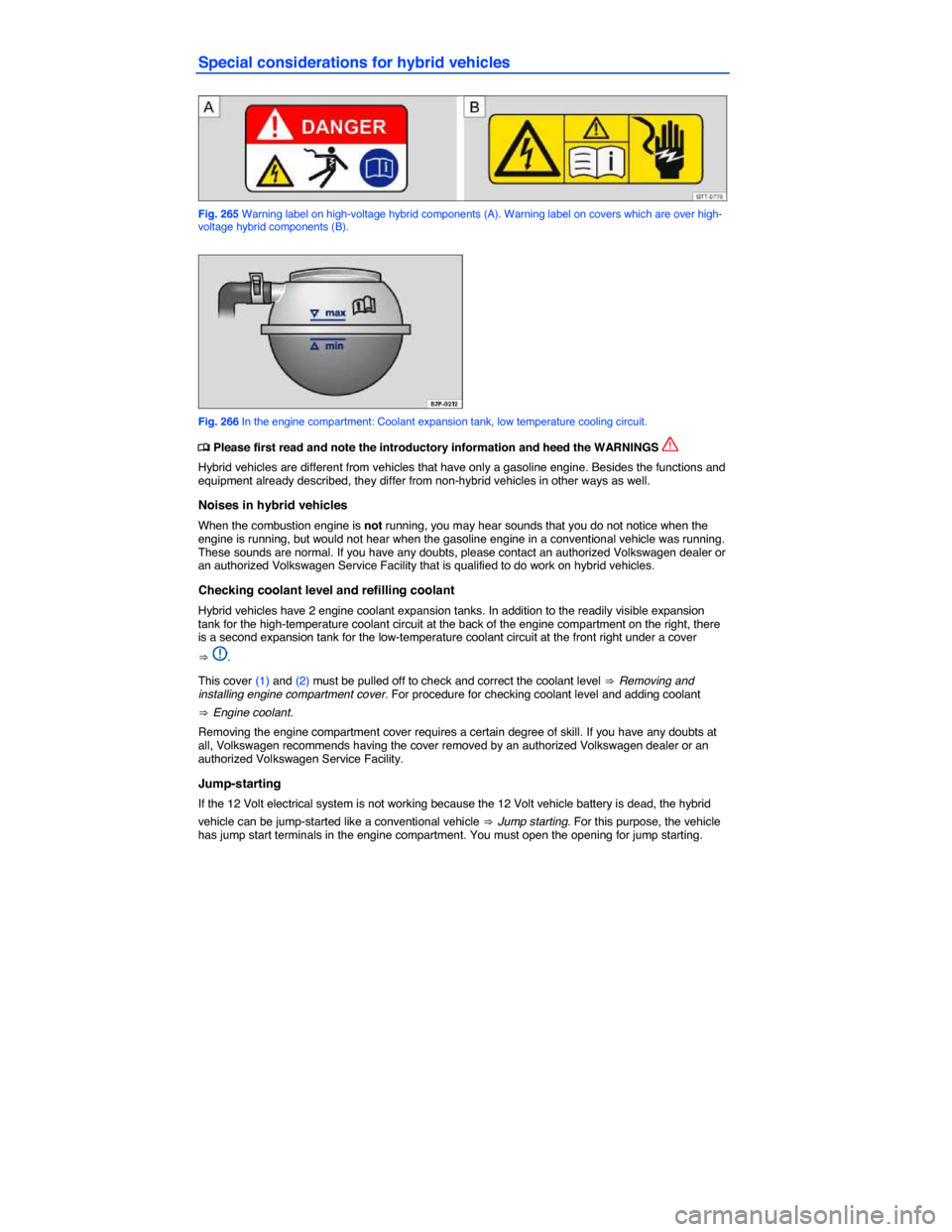
Special considerations for hybrid vehicles
Fig. 265 Warning label on high-voltage hybrid components (A). Warning label on covers which are over high-voltage hybrid components (B).
Fig. 266 In the engine compartment: Coolant expansion tank, low temperature cooling circuit.
�
Page 417 of 620
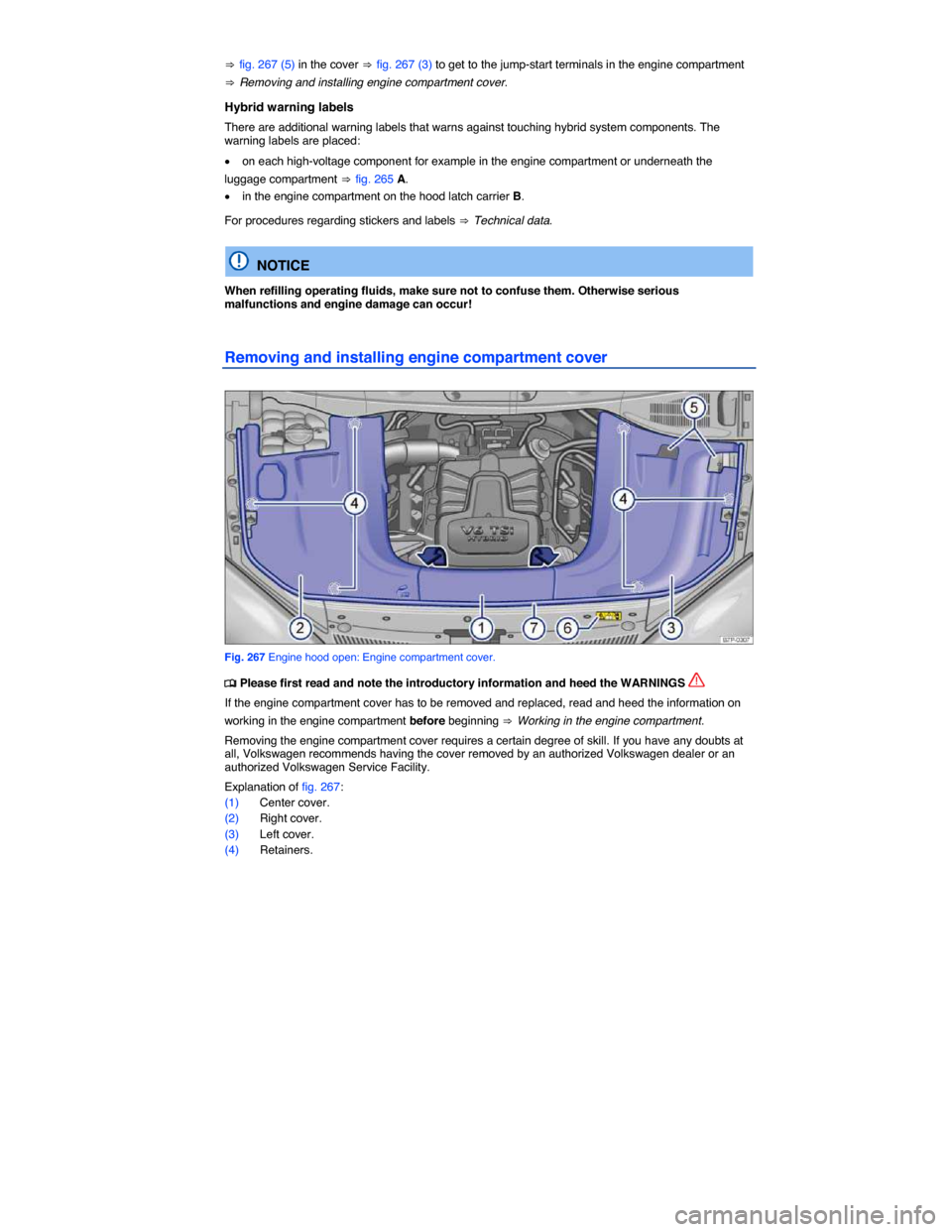
⇒ fig. 267 (5) in the cover ⇒ fig. 267 (3) to get to the jump-start terminals in the engine compartment
⇒ Removing and installing engine compartment cover.
Hybrid warning labels
There are additional warning labels that warns against touching hybrid system components. The warning labels are placed:
�x on each high-voltage component for example in the engine compartment or underneath the
luggage compartment ⇒ fig. 265 A.
�x in the engine compartment on the hood latch carrier B.
For procedures regarding stickers and labels ⇒ Technical data.
NOTICE
When refilling operating fluids, make sure not to confuse them. Otherwise serious malfunctions and engine damage can occur!
Removing and installing engine compartment cover
Fig. 267 Engine hood open: Engine compartment cover.
�
Page 418 of 620
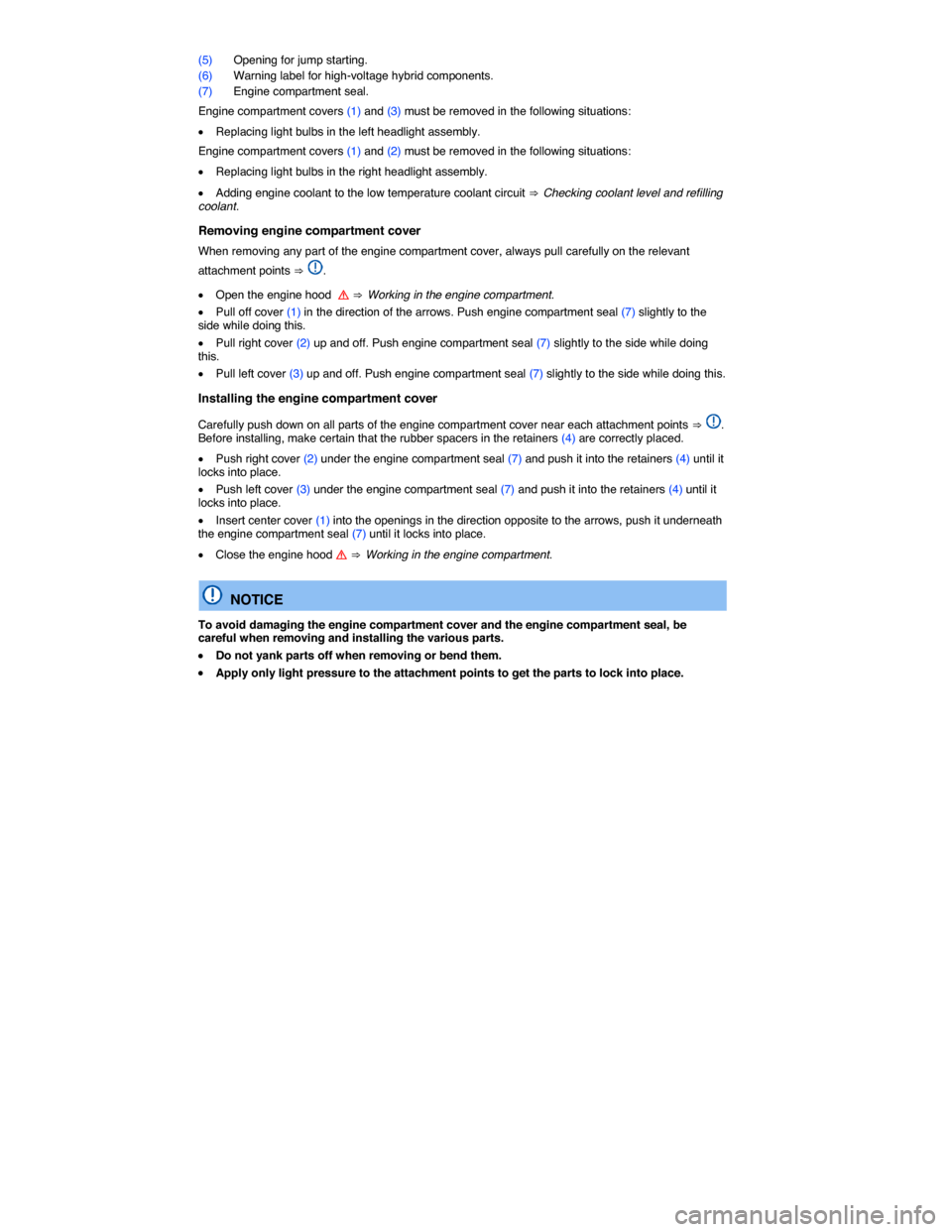
(5) Opening for jump starting.
(6) Warning label for high-voltage hybrid components.
(7) Engine compartment seal.
Engine compartment covers (1) and (3) must be removed in the following situations:
�x Replacing light bulbs in the left headlight assembly.
Engine compartment covers (1) and (2) must be removed in the following situations:
�x Replacing light bulbs in the right headlight assembly.
�x Adding engine coolant to the low temperature coolant circuit ⇒ Checking coolant level and refilling coolant.
Removing engine compartment cover
When removing any part of the engine compartment cover, always pull carefully on the relevant
attachment points ⇒ .
�x Open the engine hood �
Page 419 of 620

Heating and air conditioning
�
Page 420 of 620
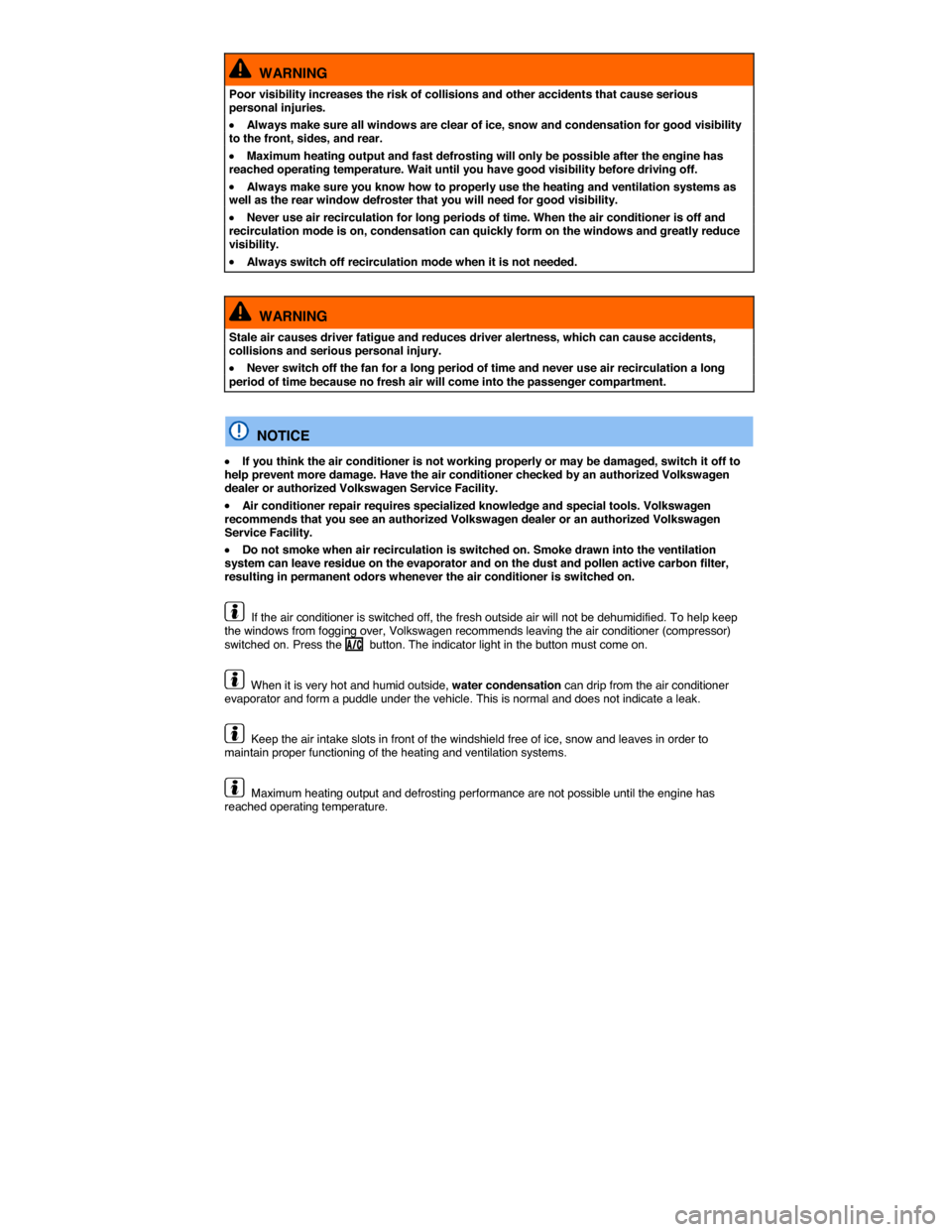
WARNING
Poor visibility increases the risk of collisions and other accidents that cause serious personal injuries.
�x Always make sure all windows are clear of ice, snow and condensation for good visibility to the front, sides, and rear.
�x Maximum heating output and fast defrosting will only be possible after the engine has reached operating temperature. Wait until you have good visibility before driving off.
�x Always make sure you know how to properly use the heating and ventilation systems as well as the rear window defroster that you will need for good visibility.
�x Never use air recirculation for long periods of time. When the air conditioner is off and recirculation mode is on, condensation can quickly form on the windows and greatly reduce visibility.
�x Always switch off recirculation mode when it is not needed.
WARNING
Stale air causes driver fatigue and reduces driver alertness, which can cause accidents, collisions and serious personal injury.
�x Never switch off the fan for a long period of time and never use air recirculation a long period of time because no fresh air will come into the passenger compartment.
NOTICE
�x If you think the air conditioner is not working properly or may be damaged, switch it off to help prevent more damage. Have the air conditioner checked by an authorized Volkswagen dealer or authorized Volkswagen Service Facility.
�x Air conditioner repair requires specialized knowledge and special tools. Volkswagen recommends that you see an authorized Volkswagen dealer or an authorized Volkswagen Service Facility.
�x Do not smoke when air recirculation is switched on. Smoke drawn into the ventilation system can leave residue on the evaporator and on the dust and pollen active carbon filter, resulting in permanent odors whenever the air conditioner is switched on.
If the air conditioner is switched off, the fresh outside air will not be dehumidified. To help keep the windows from fogging over, Volkswagen recommends leaving the air conditioner (compressor) switched on. Press the �!�